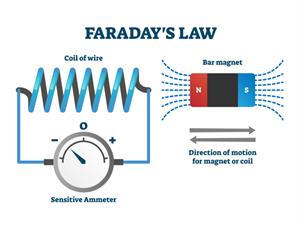
PUMPA - SMART LEARNING
எங்கள் ஆசிரியர்களுடன் 1-ஆன்-1 ஆலோசனை நேரத்தைப் பெறுங்கள். டாப்பர் ஆவதற்கு நாங்கள் பயிற்சி அளிப்போம்
Book Free DemoIn the previous section, we did an activity with the moving magnet around a fixed conductor.
From that activity, we found that the motion of a magnet with respect to the coil produces an induced potential difference, which sets up an induced electric current in the circuit.
This process is called Electromagnetic induction.
Electromagnetic induction:
Electromagnetic or magnetic induction is the process of creating an Electromotive Force (EMF) or potential difference or voltage across an electrical conductor in a changing magnetic field. It is also produced when an electrical conductor is constantly moving in a stationary magnetic field.
From that activity, we found that the motion of a magnet with respect to the coil produces an induced potential difference, which sets up an induced electric current in the circuit.
This process is called Electromagnetic induction.
Electromagnetic induction:
Electromagnetic or magnetic induction is the process of creating an Electromotive Force (EMF) or potential difference or voltage across an electrical conductor in a changing magnetic field. It is also produced when an electrical conductor is constantly moving in a stationary magnetic field.
Michael Faraday found Electromagnetic induction in 1831, and James Clerk Maxwell mathematically described it as Faraday’s law of induction.
Faraday discovered that certain factors affect this production of voltage or potential difference.
They are:
- Number of Coils: The induced voltage or potential is directly proportional to the number of turns/coils of the wire. The greater the number of turns, the greater is the voltage or potential difference produced.
- Changing Magnetic field: Induced voltage or potential difference is affected by changing the magnetic field. This can be done by either moving the magnetic field around the fixed conductor or moving the conductor in the stationary magnetic field.
Faraday's law of Electromagnetic induction:
First law:
Whenever a coil in the magnetic field causes an Electromotive Force (EMF) to be induced in the coil, this emf induced is called Induced emf. The current will also flow through the circuit if the conductor circuit is closed, called induced current.

Faraday's Law
Second law:
Faraday's second law states that the magnitude of emf induced in the conductor is equal to the rate of change of flux that linkages with the coil. The flux linkage of the coil is the product of the number of turns in the coil and flux associated with the coil.
Applications of Electromagnetic induction:
- Electromagnetic induction in AC generator
- Electrical transformers
- Magnetic flow meter
- Electric guitars and Electric violins